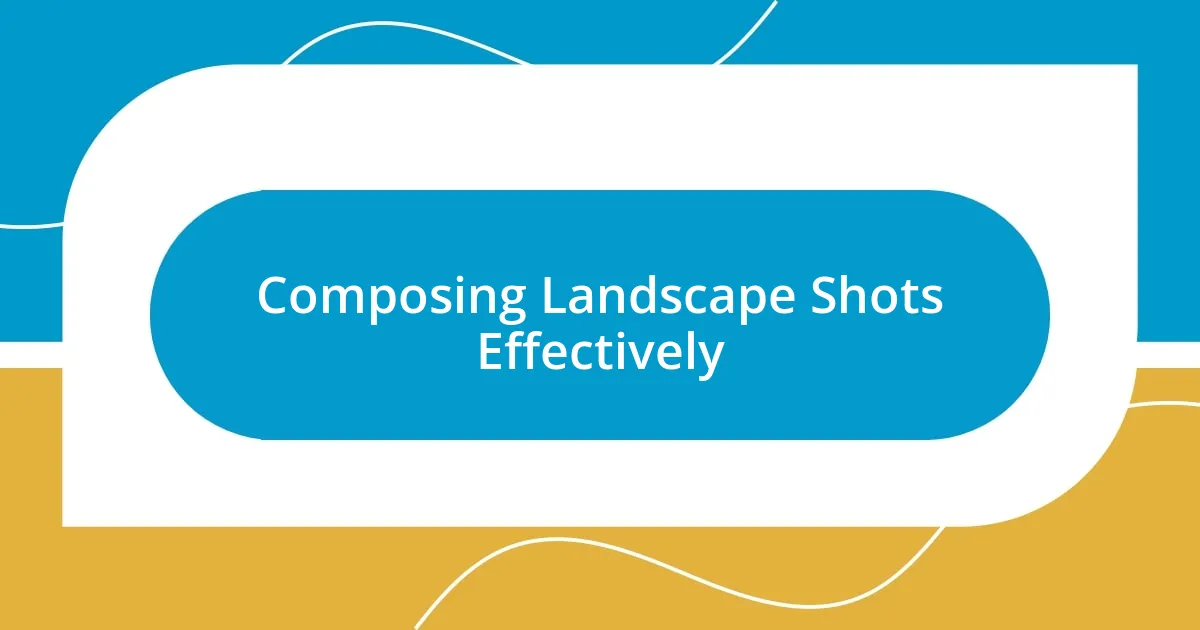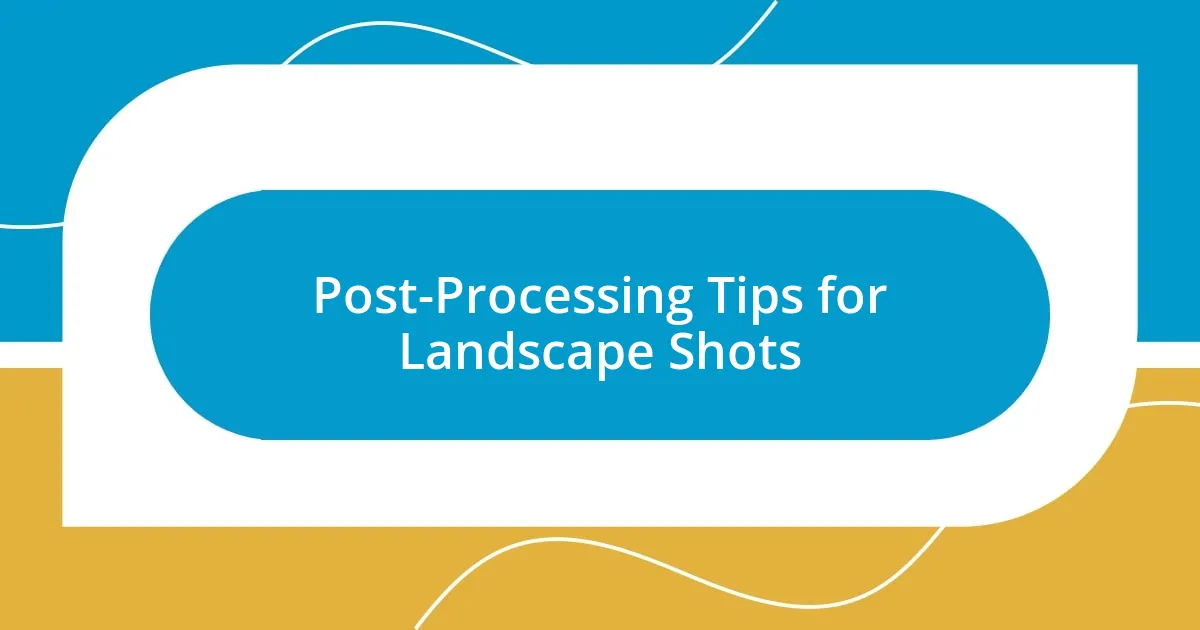Key takeaways:
- Employing the rule of thirds and experimenting with angles can significantly enhance composition in landscape photography.
- Understanding different lighting conditions, such as golden hour and stormy weather, can transform the mood and quality of images.
- Mastering camera settings—like using a smaller aperture for sharpness and appropriate shutter speeds for desired effects—is crucial for capturing landscapes effectively.
- Post-processing techniques, including adjusting contrast and using graduated filters, can revive and enhance the vibrancy of landscape photographs.

Understanding Landscape Photography Techniques
Understanding the nuances of landscape photography techniques can truly elevate your images. For instance, I remember the first time I experimented with the rule of thirds; it was a game-changer. By simply aligning my subject with these imaginary gridlines, I noticed an immediate improvement in the composition of my shots. Have you ever noticed how a well-placed subject can draw the viewer in?
Another technique that has profoundly impacted my work is mastering long exposure photography. I’ll never forget a serene evening at a lakeside when I decided to try it for the first time. The silky smoothness of the water and the ethereal quality of the sky amazed me, as it transformed what could have been a simple snapshot into an almost dreamlike representation of that moment. Isn’t it fascinating how patience and timing can transform an ordinary scene into a captivating story?
Additionally, understanding light is crucial in landscape photography. I learned that the golden hours—just after sunrise and before sunset—paint a scene in warm tones that can evoke strong emotions. A late afternoon shoot at a nearby mountain taught me this vividly; the light danced on the peaks and bathed the valley below in a magical glow. What settings have you explored during these enchanting hours?

Composing Landscape Shots Effectively
Composing effective landscape shots hinges on thoughtful framing and an eye for detail. One afternoon, while hiking in a dense forest, I found myself captivated by a narrow stream flowing through the trees. By adjusting my position and lowering my camera angle, I could capture the shimmering water in the foreground with the towering trees as a backdrop. This taught me that sometimes, moving just a few steps can completely transform a shot.
Here are some tips that have helped me in composing my landscape photographs:
- Utilize Leading Lines: Look for natural lines, like paths or rivers, to draw the viewer’s eye into the scene.
- Forethought on the Focal Point: Identify the main subject, whether it’s a mountain peak or a solitary tree, and compose your shot to highlight it.
- Vary Your Perspectives: Experiment with different heights and angles; a low angle can give a sense of grandeur to a small subject.
- Use Framing: Incorporate elements from the environment, like branches or rocks, to create a natural frame that enhances the depth of the image.
- Balance Elements: Aim for a balance within the frame to avoid a cluttered look; mindful placement of elements can yield a more harmonious composition.
By incorporating these elements, I’ve noticed a significant difference in how my landscapes resonate with viewers.

Utilizing Lighting and Weather Conditions
Utilizing light and weather conditions can dramatically influence the mood and quality of your landscape shots. I still vividly recall capturing a stormy sky over a serene lake. The dark, swirling clouds were about to release their contents, and I rushed to set up my camera. As the first raindrops fell, the contrast between the threatening sky and the reflective water created a haunting beauty that transformed an ominous situation into a magical moment. Have you ever chased the weather to get that perfect shot?
I’ve also come to appreciate how varying weather conditions can turn the mundane into the extraordinary. A foggy morning when I ventured into a nearby field was a revelation; the thick mist softened the details, making the world seem almost surreal. I remember how the muted colors enveloped everything, bringing a hush to the scene. It taught me that sometimes embracing the unpredictable can lead to the most compelling photographs. Have you ever let the weather shape your creative approach?
Lighting is another game changer that I’ve become quite adept at utilizing. During one trip to a scenic overlook, I watched how the late afternoon sun began to dip behind the hills, casting long shadows and creating a tapestry of colors across the landscape. That moment, when the light kissed the foliage and the sky transformed into a canvas of pink and gold, was a reminder of why I love this art form. How has lighting changed your perspective on your shots?
| Weather Condition | Lighting Effect |
|---|---|
| Sunny | Bright and vibrant colors |
| Cloudy | Soft, diffused light |
| Foggy | Mystical, ethereal quality |
| Stormy | High contrast and dramatic effects |
| Golden Hour | Warm tones and shadows |

Mastering Camera Settings for Landscape
Mastering the camera settings for landscape photography is crucial to capturing the essence of a scene. I remember one sunset shoot where I had my aperture set wide open, thinking it would let in more light and create a dreamy depth of field. Instead, I ended up with blurred foreground details that distracted from the stunning sky. This taught me that for landscapes, a smaller aperture—like f/11 or f/16—is often better. It ensures sharpness across the entire frame, which is vital when you’re trying to portray the vastness of nature.
Another lesson came from my experiences with shutter speed. On a trip to a cascading waterfall, I was tempted to use a fast shutter speed to freeze the motion. Then I realized the beauty of long exposure; I switched to a slower shutter speed, and the water transformed into silky smooth ribbons. Have you ever witnessed how the right shutter speed can completely alter the mood of your shot? Capturing movement creates a sense of dynamism, while a fast speed can lend a sense of crispness to rugged landscapes.
Don’t underestimate the importance of ISO either. I learned this on a misty morning while photographing in low light. I initially cranked up my ISO too high, thinking it would solve my exposure problems, only to find that it introduced graininess to my images. I now find a balance; keeping my ISO low, unless absolutely necessary, helps produce clearer, cleaner photos. It’s about achieving the right combination of settings to enhance the natural beauty of the landscape. What camera settings have you adjusted to elevate your landscape photography?

Post-Processing Tips for Landscape Shots
Post-processing is where I find the magic of landscape photography truly comes to life. After a day spent shooting, I remember eagerly sitting down at my computer, ready to take a closer look at my images. For instance, during a mountain hike, I captured a stunning sunrise, but the colors looked flat on my screen. By adjusting the contrast and enhancing the saturation, I breathed new life into that photo, making the oranges and pinks leap off the frame. Have you ever had a dull shot transform into something vibrant with just a few tweaks?
One of the tools that has significantly improved my landscape photos is applying graduated filters during post-processing. I recall editing an image of a sunlit field with a dramatic sky; the sky was washed out compared to the rich tones of the foreground. By using a graduated filter effect, I was able to balance the exposure and emphasize both elements effectively. It was exhilarating to see how this simple adjustment created harmony in the image. Do you find that filters play a role in your editing process?
I also emphasize sharpening my images while being mindful not to overdo it. I remember my first experience with sharpening—initially, I cranked it up too high, resulting in an unnatural look. Now, I apply just enough to bring out the details of rugged cliffs or delicate foliage without compromising the organic feel of the landscape. It’s a fine balance, and I often ask myself: how can I make this image look true to life while enhancing its beauty? After all, the goal is to invite viewers into the scene as if they were there with me.














